Be prepared to care for pregnant and postpartum patients in critical care settings.
Takeaways:
- Some critical care nurses have reported that they don’t feel prepared to care for pregnant and postpartum patients with serious conditions.
- Nursing management of critically ill obstetric (OB) patients relies on a systematic and consistent approach to nursing assessment.
- OB patients who are admitted to critical care settings may present a unique set of challenges.
ALTHOUGH evidence-based nursing guidelines exist to direct the care of acute and chronic conditions in obstetric (OB) patients while they’re in OB settings, few if any such guidelines exist for providing care to these same patients in emergency departments and intensive care units (ICUs). However, OB patients can be admitted to critical care settings with severe conditions—pre eclampsia/eclampsia, postpartum hemorrhage (PPH), hemolysis/elevated liver enzymes/low platelet count (HELLP) syndrome, diabetes, cardiomyopathy, complications from anesthesia, renal failure, sepsis, stroke, amniotic or blood clot embolism, placental abruption/previa/accreta, or trauma—that require rigorous management.
Some critical care nurses have reported that they don’t feel prepared to care for pregnant and postpartum patients with serious conditions. Understanding the unique challenges you might face with these patients can help you confidently care for them. In this article, we’ll focus on two of the most common types of conditions seen in OB patients: hypertensive disorders and hemorrhagic disorders.
Hypertensive disorders
Hypertensive disorders—preeclampsia and eclampsia—are the most common medical complications of pregnancy and the leading cause of ICU admissions during pregnancy and after birth.
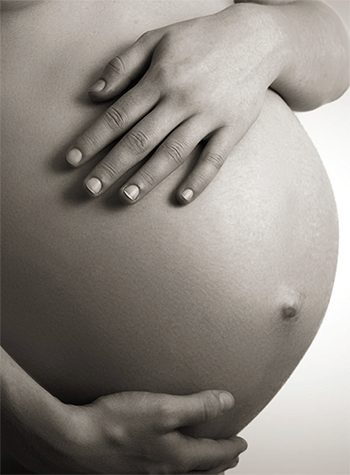

Preeclampsia, defined as the onset of hypertension after the 20th week of pregnancy with or without proteinuria, is a leading cause of maternal morbidity and mortality. Although the exact cause of preeclampsia is unknown, it’s a result of generalized vasoconstriction and vasospasm that ultimately culminates in multisystem failure. It’s primarily related to uteroplacental insufficiency and premature birth. Preeclampsia can develop and progress rapidly, and the earliest signs often go unnoticed by the patient. The disorder won’t begin to resolve until after the baby is born and the placenta is delivered.
Signs and symptoms
Signs of preeclampsia include blood pressures (BPs) with systolic readings ≥ 160 mmHg or diastolic readings ≥ 110 mmHg on two or more occasions at least 4 to 6 hours apart while the patient is on bed rest. Other signs include lab results indicating thrombocytopenia (with platelets < 100,000/microliter) and impaired liver function presenting as persistent right upper quadrant or epigastric pain that doesn’t respond to medication and/or abnormally elevated liver enzymes (up to two times the normal concentration). Renal insufficiency can be progressive evidence of preeclampsia; serum creatinine concentrations> 1.1 mg/dL or a doubling of the serum creatinine concentration in the absence of renal disease maybe present. Cerebral edema may occur with accompanying visual disturbances, such as blurred vision, dim or dark spots, and even blindness. In addition, patients with pre eclampsia may present with oliguria evidenced by < 500 mL of urine in 24 hours.
Without immediate care, this multiorgan, multisystem disorder can lead to increased morbidity and mortality for both mother and baby.
Management
Nursing management goals for patients with severe preeclampsia include improved placental blood flow and fetal oxygenation and prevention of seizures and other maternal complications (stroke, heart failure, and multiorgan/multisystem failure).
Antepartum patients are kept in bed, preferably in the lateral position to optimize fetal circulation. Keep the environment quiet, and limit external stimuli (lights, monitors, visitors). The frequency of fetal monitoring should be individualized but may depend on gestational age, the provider’s orders, and maternal status. Fetal monitoring is a specialized skill requiring collaboration with an experienced OB nurse.
Labetalol, hydralazine, and ni fed i pine are the first line drugs of choice to control severe hypertension because of their efficacy and preservation of uteroplacental blood flow. Medication side effects may include subtle physiological changes such as weight gain, edema, headache, oliguria, epigastric and/or right-sided pain, and fetal distress.
To control seizures, the provider may order magnesium sulfate. This drug acts to relax smooth muscles(such as the uterus) and reduce vaso constriction, which promotes circulation to the patient’s vital organs and through the placenta to the fetus. Increased circulation to the kidneys may cause diuresis. Closely monitor the patient’s BP, pulse, and respirations every 15 to 30 minutes, and check urinary output and presence of deep tendon reflexes.
In addition, monitor the patient for headache, level of consciousness, visual disturbances, and epigastric pain. Lab values to watch include magnesium level, platelet count, creatinine clearance, uric acid, aspartate and alanine amino transferase, prothrombin and partial thromboplastin time, fibrinogen, and fibrin split products. Keep the antidote calcium gluconate at the bedside when treating patients with magnesium.
If the patient’s condition worsens, check for evidence of fetal distress or fetal demise; implement seizure precautions and care; assess for eclampsia, pulmonary edema, placental abruption, and disseminated intravascular coagulation (DIC); and monitor lab values for multisystem involvement. Imminent delivery is indicated if fetal or maternal assessment reveals these critical changes.
Hemorrhagic disorders
The second most common diagnosis for admitting OB patients to the ICU is PPH. Patients are admitted to treat hemodynamic instability and coagulopathy.
Overview
Diagnosing and treating PPH can be complicated because blood loss and fluid replacement related to birth are often inaccurately reported and underestimated. The diagnosis is made even more difficult because most women of childbearing age are young and healthy and can easily maintain normal BP, even with large amounts of blood loss, before serious physiological decompensation occurs. Most women with severe PPH in an ICU will develop DIC, a pathologic form of clotting that causes widespread external and internal bleeding.
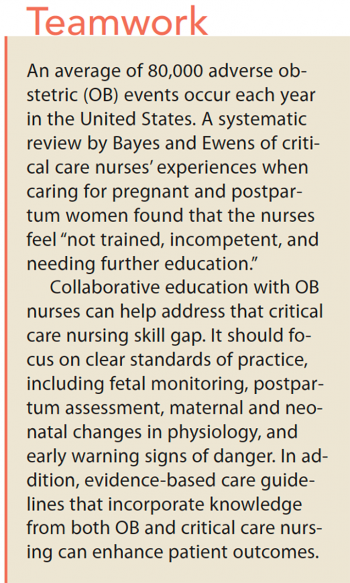

Critical care nurses are skilled at recognizing the signs and symptoms of hypovolemic shock, but they rarely encounter patients with PPH and OB patients with DIC. Before and after the patient with PPH gives birth, assess for signs of abnormal or uncontrolled bleeding from the vagina, surgical sites (such as the cesarean delivery incision), and puncture wounds (I.V., injection, and epidural sites). Bleeding may indicate DIC and require immediate medical intervention.
Signs of hypovolemic shock include increased pulse rate, falling BP, and increased respirations. Peripheral pulses will become weak or thready, and the skin will become cool, moist, pale, and eventually cyanotic. Urinary output will decrease to ≤ 30 mL/hour until it’s absent. In addition, hemoglobin and hematocrit levels will decrease. The patient’s mental status will change; she’ll become restless, agitated, and have difficulty concentrating. Patients with PPH require an astute nurse to identify the early signs of hypovolemic shock and DIC.
Management
Medical management involves correcting the primary or underlying cause of DIC. Nursing managementof PPH and DIC relies on a systematic and consistent approach tonursing assessment. This allows the nurse to immediately identify and prioritize care in response to subtle changes in the patient’s condition. Based on the ongoing assessment, the nurse is in a position to choose interventions that are appropriate to the clinical manifestations observed.
Beyond critical care
When caring for postpartum patients in the ICU, your first priority is stabilizing the physiologic condition that required intensive care in the first place. After that, you’ll need to address postpartum assessments and possibly support breastfeeding and mother-child bonding. (See Postpartum assessment.) OB nurses routinely conduct these assessments and provide this care to their patients, but this may be new territory for some critical care nurses. Your expert OB nurse colleagues can be your partners in caring for critically ill postpartum patients and their infants. (See Teamwork.)
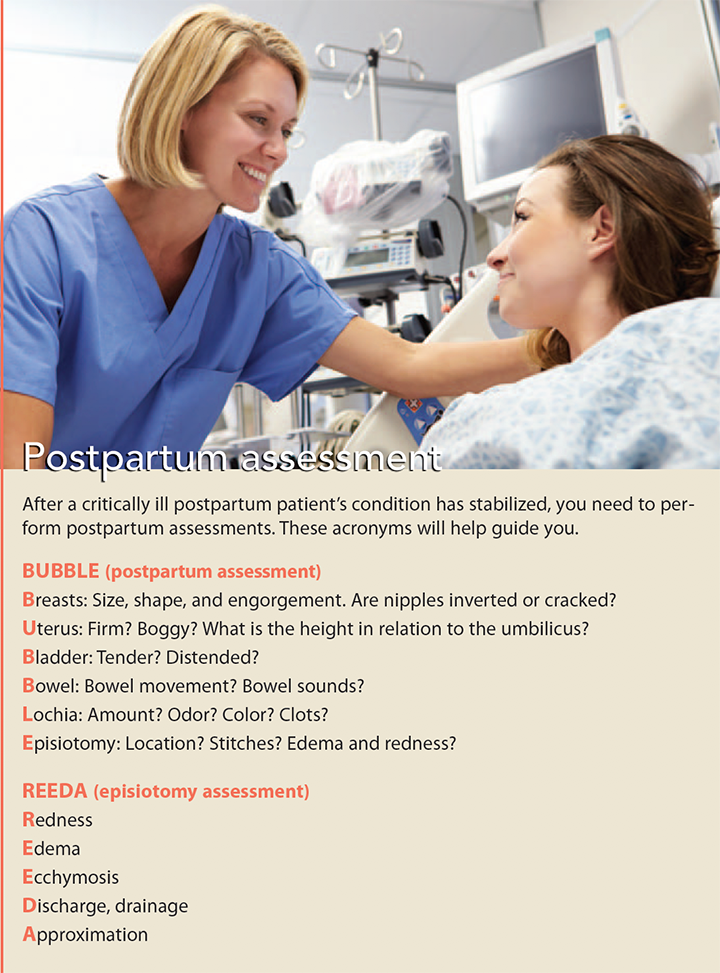

Breastfeeding
After critical care issues are resolved, breastfeeding represents areturn to the expected normalcy of childbirth. You may be asked to support or participate in maternal-infant bonding, breast pumping, or breastfeeding, especially if a lactation consultant isn’t available. (See Breastfeeding resources.)
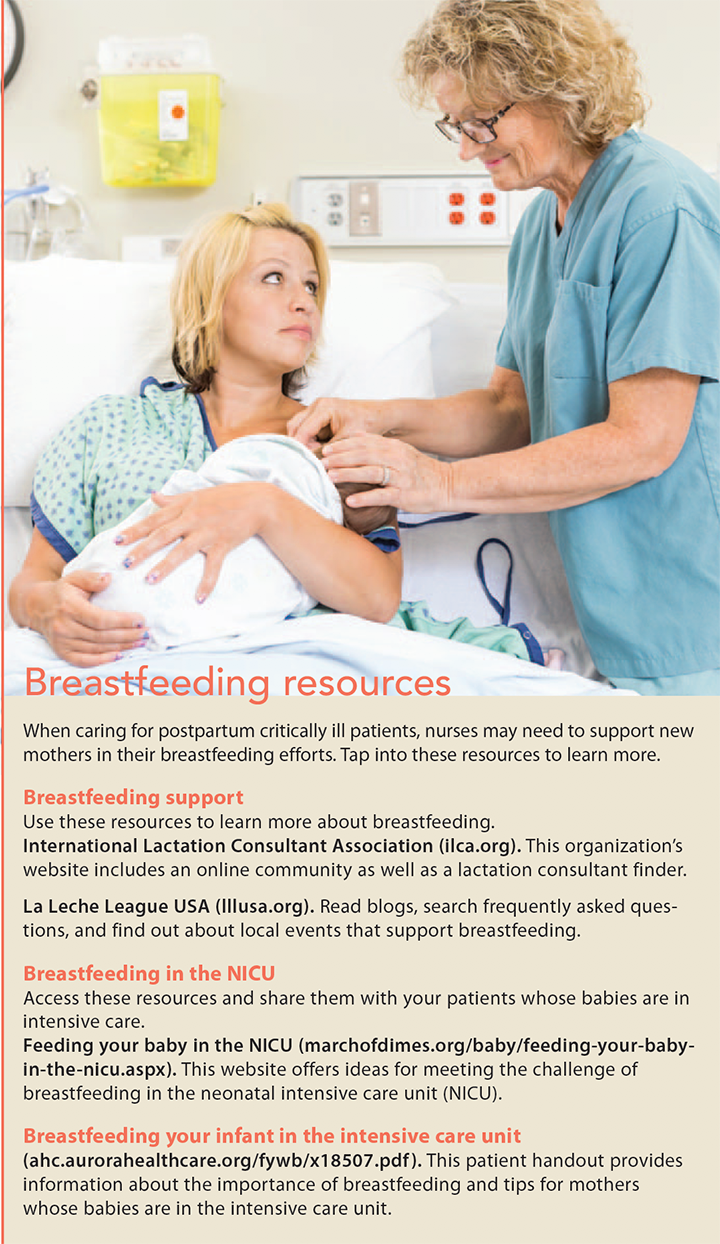

Bleeding disorders may result in difficulty breastfeeding because of decreased breast milk production. Studies show that significant postpartum blood loss may result in challenges initiating and sustaining breastfeeding, which will require more education and support and may lead to long-term emotional effects for the mother. Intervention requires time and patience and an understanding of breastfeeding physiology. Breastfeeding often needs to be learned by both mother and baby, particularly when medical complications intervene.
Postpartum patients who are cared for in the ICU report wanting to be recognized as new mothers. They’ve been separated from their babies, and they want nurses to acknowledge and act on their plans for breastfeeding or bottle feeding and address medication safety, milk expression, baby care, and barriers (such as distance from the baby).
Unique challenges
OB patients who are admitted to critical care settings may present a unique set of challenges. Stabilizing the patient’s acute condition is your priority, but antepartum and postpartum assessment, in collaboration with your OB nurse colleagues, can help ensure good outcomes for both mother and child.
The authors work at the University of North Carolina Wilmington. Debra A. Hrelic is the RN-BSN program coordinator, and Kellie M. Griggs is an assistant professor.
Selected references
Bahadur BR, Kodey P, Tanniru J, Tirumala S. Study of outcome of obstetric emergencies admitted to intensive care unit. Int J Reprod Contracept Obstet Gynecol. 2018;7(7):2909-14.
Bayes S, Ewens B. Registered nurses’ experiences of caring for pregnant and postpartum women in general hospital settings: A systematic review and meta-synthesis of qualitative data. J Clin Nurs. 2017;26(5-6):599-608.
Henry L, Britz SP. Loss of blood = Loss ofbreast milk? The effect of postpartum hemorrhage on breastfeeding success. Poster presentation. J Obstet Gynecol Neonatal Nurs.2013. onlinelibrary.wiley.com/doi/full/10.1111/1552-6909.12198
Hinton L, Locock L, Knight M. Maternal critical care: What can we learn from patient experience? A qualitative study. BMJ Open. 2015;5(4):e006676.
Kawilarang S, Negara KS. Characteristics of the obstetric patients admitted to the Intensive Care Unit of Sanglah General Hospital in 2013-2016. Crit Care Shock. 2017;20(1):4-9.
Lowdermilk DL, Perry SE, Cashion K, AldenKR, Olshansky EF. Hypertensive disorders. In: Maternity & Women’s Health Care. 11thed. St. Louis, MO: Elsevier; 2016:653-68.
Lowe SA. Obstetric medicine and the critically ill pregnant woman. Obstet Med. 2016;9(4):147.
Murray SS, McKinney ES, Holub K, Jones, R.Complications of pregnancy. In: Foundations of Maternal-Newborn and Women’s Health Nursing. 7th ed. St. Louis, MO: Elsevier;2019:208-31.
Rippin A. Evidence-based design: Structuring patient- and family-centered ICU care. AMA J Ethics. 2016;18(1):73-76.
Vesel J, Nickasch B. An evidence review andmodel for prevention and treatment of postpartum posttraumatic stress disorder. NursWomens Health. 2015;19(6):504-25.

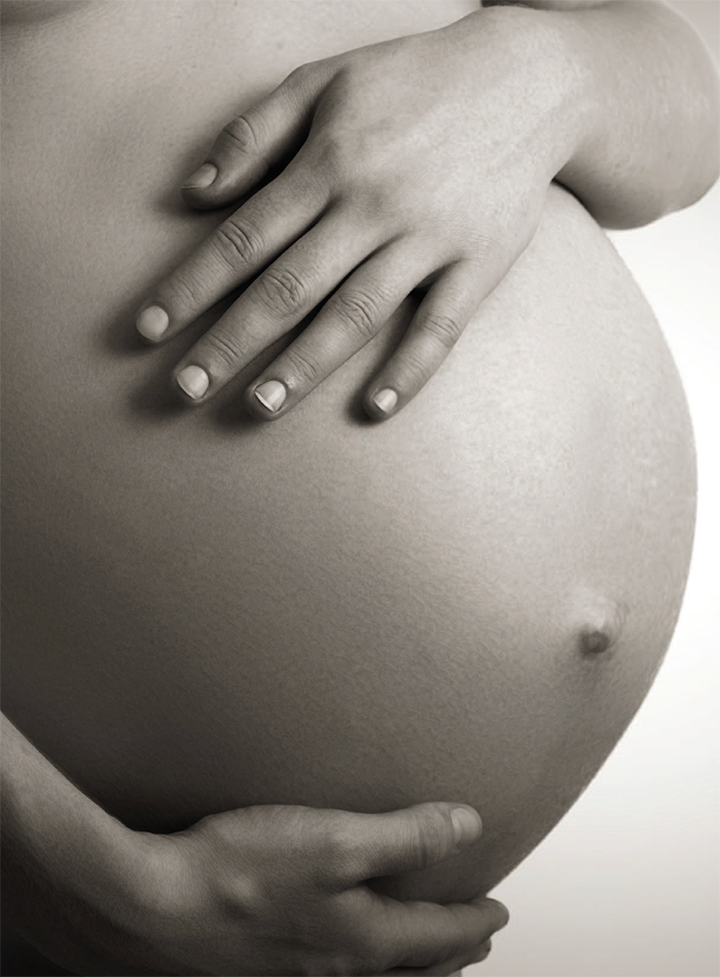

















1 Comment.
This topic is especially pertinent to me as I am a bedside nurse on a labor and delivery unit in a large hospital with over 1,200 beds, a Level 1 trauma center, and Level IV NICU. One section of the article shed light on the fact that some critical care nurses do not feel qualified to care for obstetric patients with serious conditions. The purpose of my letter is to also give a voice to the obstetric nurses involved in the care of pregnant or postpartum patients outside of perinatal units and to provide additional support for the need for collaboration among the specialties involved.
On my unit, I have observed that high-risk obstetric patients are often treated on Labor and Delivery as long as safely possible. When the need arises for them to be admitted to a higher level of care, one of our nurses is often sent with them to assume the obstetric care if it is appropriate. I have been this nurse on several occasions. In the article, it was reported that some critical care nurses do not feel prepared to care for pregnant or postpartum patients. However, to adequately address the issue, I feel it is important to add that some obstetric nurses (including myself) may feel the same way once a patient has reached a level to where they need attention in a critical care unit. To be clear, it is not the obstetric care that may be intimidating, but the unfamiliar equipment, medications, and intricate care for a critically ill patient. The feeling of intimidation can be mutual for both specialized nurses when expected to provide excellent care for a patient that encompasses an area outside of one’s expertise. I believe frequent and effective communication–even among the nurses–is one way to lessen the anxiety associated with the care of these patients.
In an article by Kennedy and Baird (2018), it states that despite recent advances in the care of critically ill pregnant patients, there are still preparation deficits in both critical care and obstetric care providers that may result in compromised bedside care. The Association of Women’s Health, Obstetric and Neonatal Nurses recognizes the educational gap and offers the online course, “Critical Care Obstetrics Education” (AWHONN, 2019). It is designed to give obstetric nurses the knowledge and tools to identify high-risk patients in critical situations so that they can be stabilized or transferred to a higher level of care if needed. I believe this educational opportunity is one practical way to increase the confidence of obstetric and possibly even critical care nurses while they care for this special population.
In summation, just as critical care nurses require more education and assistance from the perinatal world to give the best care, I believe, in a similar matter, obstetric nurses need more training and help from critical care professionals. The evidence for my observation is based on my own personal experience, the verbalized concerns of my coworkers, and also the information from the previously mentioned organizations. I appreciate American Nurse Today bringing this issue to the attention of the nursing profession, and I look forward to see the needed changes sought out and implemented.
Sincerely,
Esther Aguayo, RN